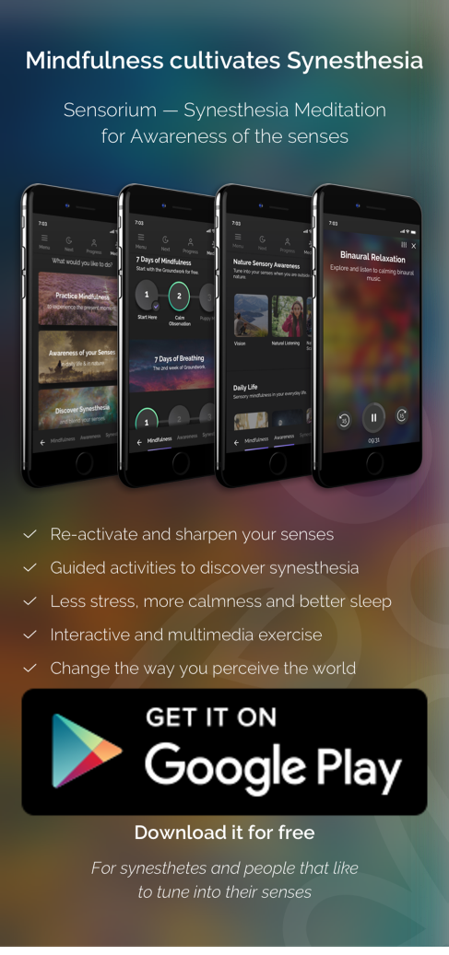Sound Synesthesia
Seeing Sounds as shapes and colors – Chromesthesia – Hear colors
Seeing sounds and hearing colors- Sound Synesthesia
“And the guitar and its green tones were dancing along the shore.”
Wouldn’t it be great to see Music in shapes and colors? Or if you could hear colors without the use of any drugs like LSD? Sound-Color Synesthesia, or Chromesthesia, is a phenomenon of people seeing sounds in shapes and colors.
Maybe you do hear music in colors! But you have not noticed it yet!
Chromesthesia is a type of synesthesia. An acoustic perception evokes a visual experience.
Some people see music in shapes and colors, they may have a perception of taste and smell, and in their fingertips, they may even feel a texture.
These synesthetic experiences are automatic and involuntary. But attention to the sense of hearing is needed to perceive it consciously.
Because so often we are distracted from the present moment in modern society, we miss the sense of hearing; and the synesthetic experiences. We do not notice that we hear the music in colors.
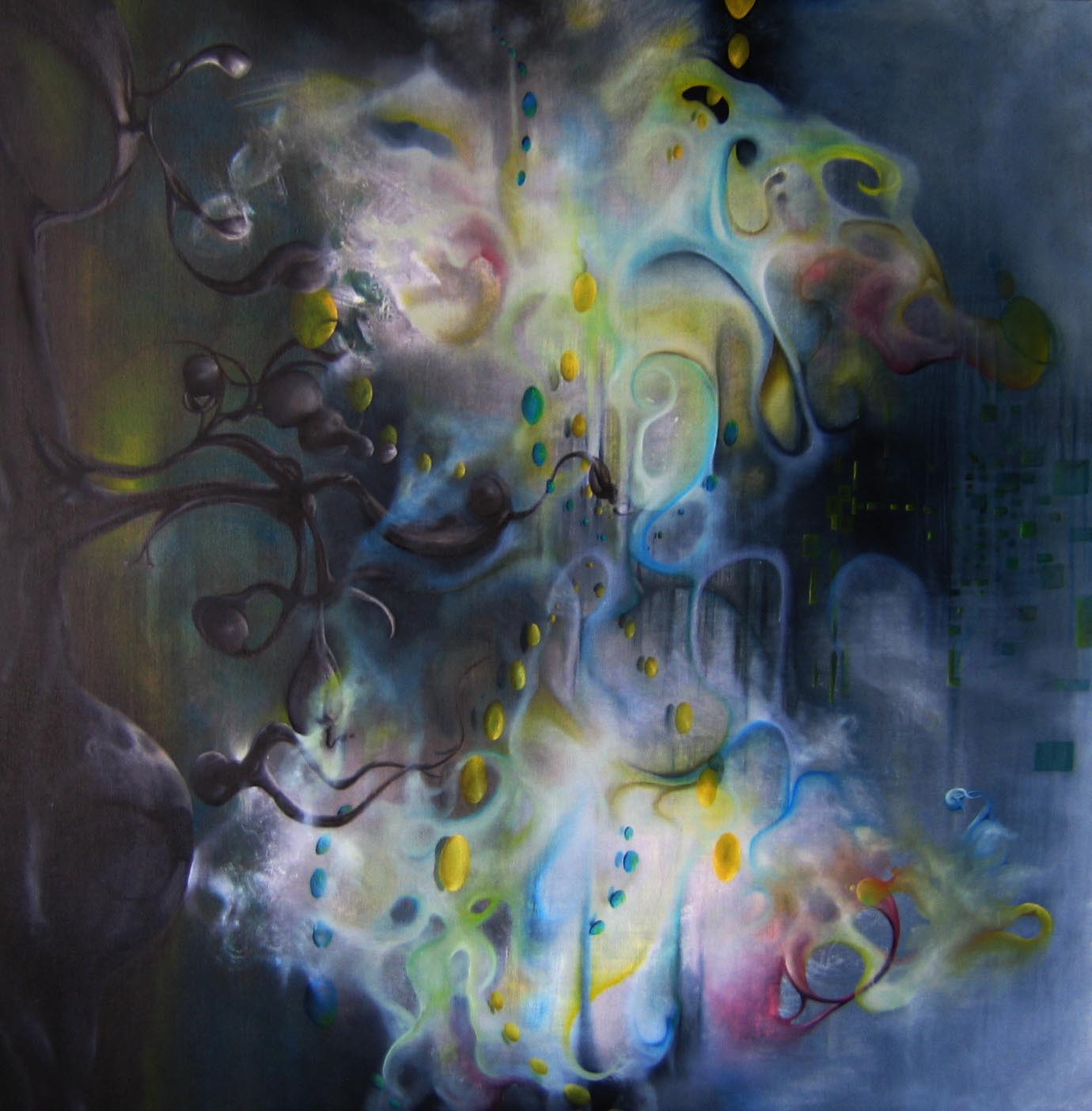
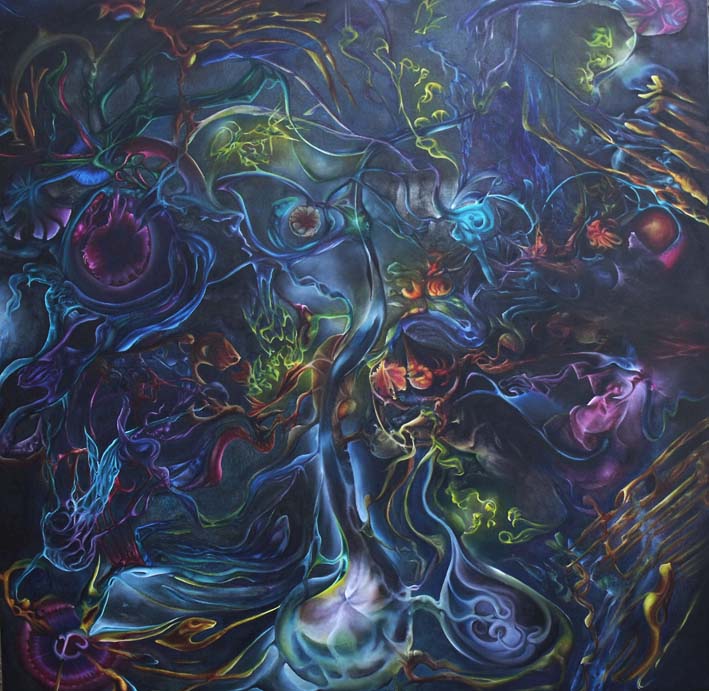
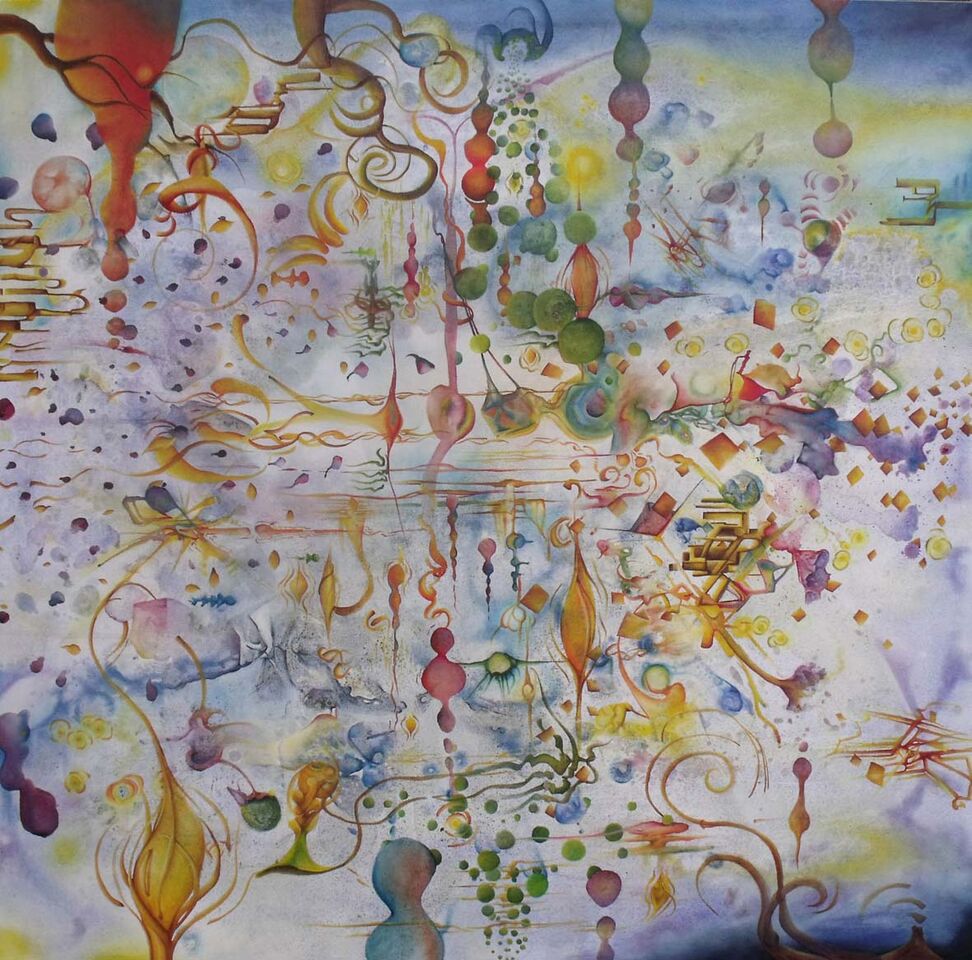
Do you see music in shapes and colors?
Before you say that you do not hear music in colors, take 5 minutes to try it out!
What is this blog post about?
- Learn what Sound – Synesthesia is and what it means to have it.
- Discover techniques to become aware of your synesthetic experiences.
- Find out if you hear colors or see sounds yourself.
- Learn about the science of the synesthetic brain.
Chromesthesia is a common type of synesthesia
Chromesthesia is one of the most common types of synesthesia. 40 % of synesthetes report having this type of synesthesia. [cytowic synesthesia
And seeing music as colors may also be one of the most exciting kinds of synesthesia.
There is a study that claims that the prevalence of sound synesthesia in the general population is 5-15%. But this study is already a little bit outdated and lacks an empirical approach.
Since there are no precise studies on the prevalence of chromesthesia, let’s instead take this as a guesstimation.
Determining the prevalence of synesthesia is challenging anyway. And whole many people have synesthesia, and they are not aware of it. For more about this read about it here [link Prevalence]
Sound triggers the perception of other senses
The conscious perception of sound may trigger the experience of shapes, movements, tastes & smells or textures, as well as luminance.
Those perceptions are somewhat abstract.
Chromesthetic experiences happen as involuntary and automatic, but you need to be aware of it.
For the sake of simplicity, as we talk about chromesthesia in this article, we mean Sound – Synesthesia in general. We do not restrict chromesthesia here to only seeing music in colors.
Consistent but individually different
These colors perceptions of sounds seem to be consistent. Similar to the Letter-Color Synesthesia, the colors of the sounds are consistent. These colors remain the same over time but are often different among synesthetes.
There are some trends for the sound-color associations.
Lower pitches are rather dark. Higher pitches are rather bright.
Such correlations are real for many of us and are called multi-sensory perception. We will talk about this again later.
Different sound sources may trigger the experience of synesthesia.
Not only music triggers chromesthetic experiences.
Also, the sounds of nature such as birds, animals, water, the beach, a dog barking and the voices of the people around us, may elicit the perception of colors and shapes.
Also, unpleasant sounds, such as the noises of cars, airplanes, construction sites and police sirens may have a visual aspect.
And you know what?
If you hear an unpleasant sound and you focus on its colors and shapes, without labeling it, it can change. It may lose it’s unpleasant attributes.
In the Sensorium [link], we have a great variety of different exercises for you with sounds of your environment.
The Sounds of Nature in Shapes and Colors
In the Nature Sounds Meditation Series, you will discover the colors and shapes of nature sounds. But we also have exercises that involve the not so pleasant sounds of a city.
These techniques, applied outdoors, are a great way to suck in the soundscapes when you are in a beautiful place, full of rich acoustic perceptions.
Do you want to experience synesthesia on the go? Download the Synesthesia Meditation App for free.
What is chromesthesia?
Chromesthesia is a type of synesthesia. In a more narrow sense, the perception of colors when listening to music. In other words, hearing music in colors. (sound -> color synesthesia).
Chromos is Greek for colors; esthesia is perception.
More broadly used, we call chromesthesia Sound Synesthesia or Music Synesthesia. So in this article, we do not only confine chromesthesia to seeing sounds in color.
We will have a look at all potential senses that may be co-activated by the sense of hearing.
The visual nature of synesthetic colors and shapes
It is a little bit more complex and also very difficult to express with words. Explaining in words the visual nature of synesthesia is tricky. So we thank Timothy Layden for his friendly permission to use his artwork and paintings [2 artworks, maybe add a sound]
The shapes of sounds are not just one square or one oval. I would instead call it an aggregate of many smaller visual units.

Such as small lines, or dots. They form an overall picture of a sound; this can be somewhat foggy and airy, or dense and spiky. These experience vary in “forms, spatial arrangements, transparency, solidity, intensity, and nuance.”
It is an abstract perception. And not something that we know from the real world, such as a house and a forest.
The visual experience of sound is not like looking at a 2-dimensional image. It is a fluent changing overall picture. And depending on where you focus, it changes, and you perceive it differently
Visual synesthetic experiences are not static; they are vivid and fluent.
The sound also does not have one static shape. It is as vivid and fluent as the sound itself.
The synesthetic experiences of sounds are of volatile. As you are listening to a sound, it changes.
As the music changes its pitch, timber, the volume and the melody, the synesthetic shapes and color develop as well.
Also, the same instruments do not evoke only one color or one shape. It also depends on the pitch, timber and the speed of the melodies.
Synesthetic experiences are hard to grasp
You see, synesthetic experiences are hard to grasp. Especially challenging is to put this experience into words. Our vocabulary is too limited to describe such sensations.
Drawing the shapes of synesthesia is more comfortable, though it is still challenging. We will talk about the opportunities for drawing sound activities later In this article.
Acoustic and musical properties influence the synesthetic experience.
In the book Wednesday is Indigo Blue, the authors point out that synesthetes respond to different acoustic and musical properties.
The perception of the synesthetic sound depends on several aspects of the music:
- Sounding Pitch: Is a note high or low?
- Pitch Class: What is the tone? (C, B, F #)
- Key: Is it a major or minor scale?
- Timbre: The quality of the tone (e.g., two different instruments playing the same sound)
- Chords: Two or more tones played at the same time
- Melody: Sequentially arranged notes.
- Volume: Is the sound high or low.
The nature of the synesthetic experience depends on all these factors.
“No wonder colored hearing is such a rich experience.” [Richard E. Cytowic]
In the SoundScapes [link] in the Sensorium, you find many different exercises, which involve all these acoustic and musical factors to support you in discovering and becoming aware of your synesthetic awareness.
By the way: “Timber” in German is “Klangfarbe” what translates literally to “color of the tone.”
And melodies also are excellent triggers for the perception of taste experiences.
Does it cover the visual space?
A frequent question is if synesthetic aspects interfere with real vision.
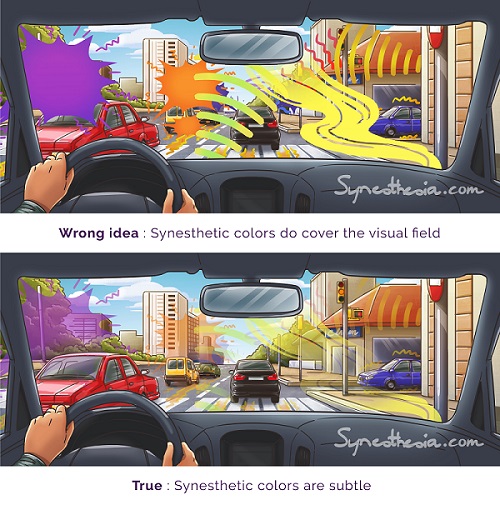
The answer is no. For example, the honk of the car in front of you won’t cover your field of vision that you cannot see the traffic light. It is not like that!
People with this type of synesthesia perceive shapes and colors somewhat in a mental space. They describe it that they see it with their “minds eyes.” The shapes and the colors are arranged in outer space.
Synesthetes that listen to music with earplugs report that the shapes and colors may appear in the head.
Loud sounds may appear to be bigger than sounds that have a lower volume.
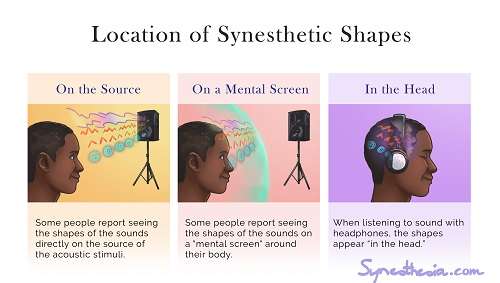
Similarity about the shapes of sound
Synesthetic experiences are consistent and differ from one synesthete to another. Still, there are certain tendencies.
For example the shapes of sounds.
Timothy Layden and Christine Söffing discovered that they perceive similar shapes for a given sound. They both made a picture of their visual experience of different sounds.
As they compared, they realized that the same sound induced very similar shapes.
So they did the following experiment with 4 different sounds:
They made many people, synesthetes, non-synesthetes, artists, non-artists draw the same sounds.
You can see some example below. It is interesting to see that particular sounds evoked the same visual pattern among different person. If you want to know in-depth what this is about, you can read more here.
Little Synesthetic Visual Game
4 Synesthetes listened to 4 sounds (1-4) and made a drawing of each of these 4 sounds.
You can see it in this illustration.
Below you find these 4 Sounds in a different order. They are now named A, B, C, and D.
Your Task is to figure out, which sound belongs to which set of drawings.
There is not a right or wrong answer. It is more for fun and you an opportunity to listen to the sounds carefully and to associate a shape with it.
You can also take a pen and paper and draw the sounds yourself.
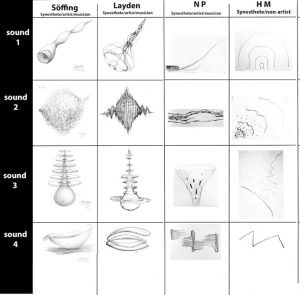
- Click on Sound A.
- Listen to it.
- Decide if Sound A belong to the drawings of Sound 1, 2, 3 or 4.
- Move to Sound B.
So, it seems that we are all a little bit multisensory and we seem to perceive sounds similarly. Violin orchestra is more a soft foggy experience; hard rock punk is slightly pointy, spiky, solid.
If you like this kind of drawing exercise, maybe you should try out our free activity of drawing sounds in the sensorium.
The visual difference between Classical Music, PsyTrance, and Pop
Different genera evoke different sets of visual experiences. You may imagine that the synesthetic experience of the various music of different genera also is very diverse.
In the SoundScape Section of the Sensorium, we have several activities with the different music of different Genera for you. Some exercises are about Classical Music, Electronica or Pop
How to become aware of sound to color synesthesia
Many people are synesthetes. The problem is that many are not aware of their ability to hear the sounds and see music in shapes.
Maybe you say:
“I do not see music in shapes and colors.”
And perhaps you are wrong.
“I do not see music in shapes and colors!” Sure?
Before you make your final decision consider the following:
- Many people are not aware of their synesthesia.
- You may be a synesthete; you did not notice it.
- There are techniques to discover and to become aware of Synesthesia.
- The best way is to perceive and to experience.
There are many people with synesthesia, but most are not aware of it.
More people than assumed in the past have sound synesthesia.
The problem is that many are not aware of there chromesthetic experiences. They miss the beauty and the benefits of it.
4 reasons why many synesthetes are unaware of synesthesia.
Synesthetes are unaware because…
- …sensational reports in the media inhibit them to identify with synesthesia.
- …the chattering mind distracts them from the present moment.
- …they are not mindful towards the senses, and consequently neither for synesthesia
- …they have never given attention to it.
2 approaches to discover how to hear colors
In the Sensorium, you find two different sets of techniques to discover and explore synesthetic experiences of sound and music.
- Synesthesia Meditation
- Drawing sound activities
If you want to jump into it right now, check out the Sensorium
There are many different reasons, why many people are not aware of synesthesia
So let’s look a little in depth at the reasons why many are not aware of synesthesia.
Sensational press reporting
The media tend to report about synesthesia a little bit exaggerated. Many readers or viewers imagine synesthesia to be a firework of the senses. But synesthesia is quite subtle.
The press states that synesthesia is a unique and rare phenomenon.
Reading about a condition that is “rare and very special,” the first thought is not that you may have that as well.
As a consequence, this inhibits people to explore their synesthetic abilities, to open their sensory channels and to identify and resonate with synesthetic experiences.
You need to give attention to your synesthetic experiences
For me, it was the case. When I was a teenager, and I read an article about people that see colors when listening to music, I thought: “that is cool, but I do not see music in colors.”
Still, I gave it a try. I turned on the radio, and I attentionally listened to music. I explored if I experience any shapes and colors. There were! And then I realized that I am a synesthete, too, and that I hear colors.
Our chattering mind distracts us from our senses
In our modern society, our minds hang too often in the past and the future. And we are missing the present moment.
It is likely that our ancestors that lived in nature were more aware of their environment because their senses were sharp and their minds more in the present moment.
Read here more about synesthetic mindful awareness.
If you are not aware of your sense of hearing, apparently you are also not aware of the synesthetic colors of music.
One goal of meditation is to shift and sustain the attention of the present moment. Mindfulness activities increase the perceptual sensitivity.
And some researchers claim that learning to meditate helps to experience synesthesia.
To support unaware synesthetes in their sensory journey, we developed Synesthesia Meditation. [link] We will tell you more about it in a minute.
If you are tired of reading, take 10 minutes and dive straight into a synesthetic activity.
How to see music in shapes and colors?
Sharpen your sense of hearing
The most crucial part to become aware of sound synesthesia is to be more aware of your sense of hearing.
As we discussed above, in our modern society, our mind dominates out attentional space. Our thoughts are looping around the past and the future, and we miss out of the present moment.
You probably know the situation that you are at a concert, and your mind starts to drift away, you then are not aware anymore of the perception of sounds.
An essential step towards becoming aware of synesthetic experiences is to be more attentive to your sense of hearing, by cultivating mindfulness towards listening.
Synesthesia Meditation: sensory mindfulness and synesthetic explorations
One of the main reasons why people are not aware of their synesthetic abilities is because they are not aware of their sensory experiences in daily life.
One goal of meditation is to increase the sensory and perceptual sensitivity. [LINK] By doing mindfulness exercises, you raise your sensory awareness. And it has been shown that meditators are more likely to unfold and perceive synesthetic experiences.
The practice is a mix of sensory mindfulness and synesthetic explorations. Over 150 exercises to increase your sensory mindfulness and your synesthetic awareness.
But first, let’s talk about how to hear colors.
The Technique for mindfulness on colors of sounds work
The core technique is always kind of the same.
- Relax and calm your mind through meditation
- Listen to a sound mindfully
- Observe if you detect a movement
- Is the sound rather bright or dark?
- Is there a color?
Try this with a sense of curiosity and patience. In the beginning, your mind may interfere and carry you away, and that is normal and perfectly fine. Just shift your attention back to the sounds.
Don’t let your mind to discourage you
As you sit and observe the sound of shapes and colors, your mind will not only carry you away.
Your mind may also feel impatience and insecurity.
“I do not have synesthesia,” “I do not perceive colors” your mind will probably think.
This behavior of your mind is to be excepted and fine.
And this is also why meditation helps us to become aware of synesthesia. Mindfulness calms the mind as we focus on the sensory experience. It opens your sensory channels with awareness.
When you realize that your mind interferes with your auditory experience, simply bring your attention back, ignoring what your mind is telling you.
Calming the mind and sharpening your ability to focus on the sensations in the present moment is a crucial part of Synesthesia Meditation.
Just give yourself some time. There is no rush.
Do you want to try it out?
Drawing the sound
Another excellent opportunity to become aware of Chromesthesia is the technique to draw the sound. Drawing the sound engages you with what you see when listening.
Botany students draw the flowers to see the details
When I was a botany student, we spent a lot of time drawing the floral parts of the plants. In this way, we had to look carefully.
Drawing it helped to sharpen the eye and to become more aware of the details of the flowers.
With Sound-Vision Synesthesia it is very similar! As you try to draw it, you need to look carefully. And so you become more aware of the experiences of the visual aspects of sound.
It is challenging to draw music, but it makes you aware of it
Drawing synesthetic perception is a little bit tricky. Synesthetic experiences of music are very volatile. It is not like a two-dimensional painting that you can draw as if it was a photograph.
Since the perceptions changes as you focus on the different aspects. For example, you zoom in and out the music, so also the visuals change.
To draw this fluidity exactly is probably not possible. Some artists do a pretty good job of painting music, though.
However, for you, it is also not the goal to create the perfect picture of the sound. The idea is that you engage with the synesthetic experiences of sound.
So, maybe give it a go!
Get a paper and some pens, and start your synesthetic journey of drawing the sounds!
Soundscapes in the Sensorium: Discover your Chromesthesia
When I found out that I am a synesthete, there was nobody to share my experiences.
I thought that I was alone.
But then I realized that many of my friends are synesthetes too. It took me many years exploring my perceptual world to become aware of the different types of synesthesia.
We want you to have the benefit of our journey. In the Sensorium you find activities to become aware of your synesthesia and to discover the different types of synesthetic experiences.
The soundscapes offer many different exercises for you to engage with your synesthetic perceptions of sounds and music.
Sound to color, shapes, texture, tastes, smells, personalities and of course, emotions.
The sound activities in the SoundScapes involve all different types of sound synesthesia.
What kind of sounds and music is in the “SoundScapes”?
Chromesthesia involves many different senses and sound stimulation. The Sensorium covers them for you!
- Nature sound Meditation: Meditate on the colors of birds and nature.
- Soundsphere Series: We start with the shapes of the color of simple sounds and make our way through melodies and pieces of music.
- Ambient Sounds: What do you hear when you are outdoors?
- Sounds of voices: These activities are about the shapes of the voices.
- Music Bouquet: Here we explore different songs and music pieces from different genera.
In the SoundScapes, you find some free exercises. If you subscribe for a free 7-day trial, you can listen to all of them.
Discover Synesthesia Meditation
Synesthesia Meditation App
Download our Synesthesia Mediation App and have your daily synesthetic explorations only one click away.
Other synesthesia involving sounds
Sound Syneshtesia is not only limited to visual experiences triggered by sound. Theoretically, you can hear colors, hear tastes, hear smells, hear touches. Or in other words, see sounds, taste sounds, smell sounds or touch sounds.
Auditory-Tactile Synesthesia: touch music with your fingers
There is also another range of different co-activated senses. For example, the feeling of touch, or also Sound-Touch Synesthesia. The scientific name for it is Auditory-Tactile Synesthesia.
As you hear a sound, you may also be able to touch it with your minds fingers. And you may feel that the acoustic experience is rather smooth or rough.
This type of synesthesia is a little bit more subtle than the Sound-Color Synesthesia. But still an interesting one you should explore.
Sound Taste Synesthesia: When you experience Music on your tongue.
One case that got a lot of media attention is the case of a musician that perceives the sound intervals of music as a taste in her mouth. She also has the perfect pitch, meaning that she can name a given music interval.
When she had a wrong taste on her tongue, she was slower in determining the sound interval. This result was the first finding of a Sound-Taste Stroop interference.
The opposite: hearing what you see
We now talked about seeing shapes and colors when hearing the sound. But, it also works the opposite. When you look at something, you may even hear it. Motion-Sound Synesthesia is a recently described synesthesia. And it is a prevalent one. Over 20% of participants in one study reported having an auditory experience when seeing the video with the morsing code below.
What do you hear when you watch this?
Discover more types of Sound-Synesthesia in the Sensorium
In the Sensorium, you find many different activities around Sound and Music Synesthesia. They engage all your senses and blend them.
Maybe you have synesthesia too!
Discover more in the Soundscapes or SenseSphere section!
Read more in the second Part about Sound Synesthesia
- What happens in the brain
- Why everybody is multi-sensory
- Famous Musicians
What happens in the synesthetic brain?
We do not know yet what the exact mechanisms are that underline synesthesia. Researchers assume that synesthetic experiences use pre-existing pathways that are present in all brains.
For example, taking hallucinogenic drugs, such as LSD may induce synesthesia-like experiences.
But the brain is not able to build new neurological pathways so fast. We can instead think about an over-activation of neuronal connections that are already there. [link frog]
Also, as we will see later, synesthetes and non-synesthetes have sound to color associations, which are not just random.
The sensory areas in our brain are not isolated from each other. They are connected
Studies show that Synesthesia runs in families. But also other factors than genes are involved (Link syn.com article)
There is evidence of hardwired connections between the auditory and visual region of the brain.
But let’s look at a simplified picture.

You can imagine the brain having two different areas. One is the visual cortex, and one is the auditory cortex. If the auditory cortex is activated, the visual cortex is also triggered. The perception of a sound leads to an experience of colors and shapes.
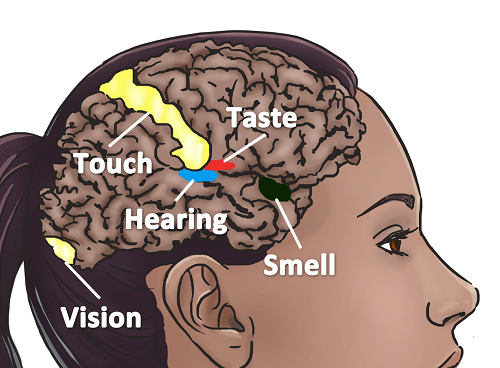
One theory of the forming of synesthesia is the neonatal pruning theory. The sensory areas and the neuronal structures in the brain of a newborn are still a little bit messy. So the senses are strongly wired. Some researchers talk about panesthesia; all is one sense. In the time after birth, these neuronal connections are pruned.
The neonatal pruning hypothesis states that for synesthetes, the pruning, or cutting off connections, is less intense. The idea is that these less pruned connections allow the synesthetic co-activations to happen.
But more evidence is needed.
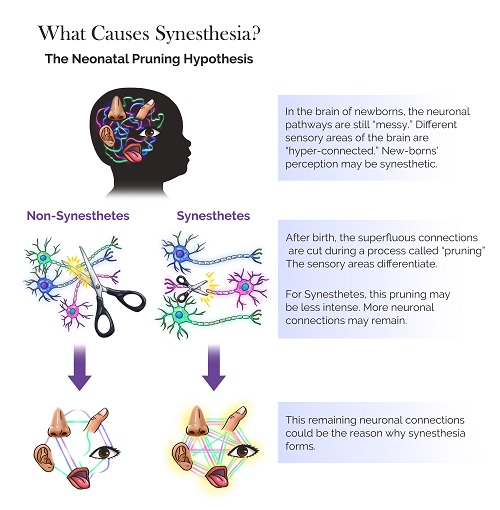
Multisensory perception of sounds is innate to all of us.
The association with color and sounds is not unique to synesthetes. The multisensory experience of sound is innate to all humans. And even to chimpanzees.
Sound evokes emotions
Let’s look at another example. Music evokes emotions. Music can be happy, but music can be sad. Music can even trigger goosebumps in us.
It is not considered a genuine type of synesthesia, but it is a multisensory experience.
Broken down, certain vibrations of the air can make you smile or cry.
Dancing: Sound stimulates the movement of your body.
Dancing, for example, could be considered as a kinesthetic experience. It is about expressing the perception of sound with the movement of the body. Some sounds may feel more smooth and flowy; others are more squared and rough.
And here as well, listening to music makes you move, makes you jump, sway and dance.
Higher pitches are bright, right?
Which of the two sounds is bright, and which is dark?
High pitches are rather bright and small. Low pitches, such as a base, are darker and bigger. Such correlations were found to also be true for chimpanzees
So, you see, we all have a multi-sensory sensorium. Our senses do not act independently. Our senses are not isolated islands. They are all pretty much interconnected.
For some, it seems the sensory areas are a little bit more connected than for others, this is called synesthesia.
McGurk: Vision deceives hearing
The sense of Hearing and vision are tightly coupled. If you see something, it may influence what you hear.
A very well known illusion is called the McGurk Effect. It demonstrates it very powerfully how hearing and vision influence each other. Watch the video
.
Kiki and bouba: Vision evokes an auditory experience
Or the other experiment with Kiki and Bouba is very well known. Which shape is Kiki and which one is Bouba?

Almost all participants agree the pointed one is Kiki; the round one is Bouba.
Also, Kiki is described to be busy and nervous, while Bouba is lazy and slow.
Seing evokes sounds.
Seeing evokes sounds! Some researchers claim that this mechanism, seeing evokes sounds, is the beginning of the evolution of language.
I imagine that our ancestors would name a plant with spiky leaves different to a plant with round leaves. And learning and naming plant is an ancient learning skill.
Our Senses Are connected. For everybody.
As a conclusion, our senses are connected. And it is in all of us, also in other animals species.
Also, think about bats. They orient in the dark merely with sounds. And there are even blind people that use echolocation. [Link to a youtube video]
It is not always easy to draw the line between our senses. Nor is it easy to say, where synesthesia ends and where multi-sensory perceptions start.
And sometimes it also does not matter too much.
More important is, that you are aware of your senses.
Maybe it is time for you to give it a go to see music in shapes and colors?
Well, then jump right into a synesthetic music activity:
Beethoven
Some musicians that are famous
Ever now and then, you may read about famous musicians that are synesthetes.
Here some honorable mentions:
- Stevie Wonder
- Hans Zimmer
- Kanye West
- Billy Joel
- Pharrell Williams
- Tori Amos.
- Lady Gaga
Most likely, many more musicians are synesthetes.
Synesthetes are more likely to play an instrument. It is important to point out that these musicians are most likely not the only musicians with synesthesia.
They are musicians that are aware of synesthesia and that had the public “coming out” as synesthetes.
I am sure, that there are many other famous or not so famous musicians that are synesthetes, too.
Maybe they are not aware of the colors of the sounds. Or it is normal for them to see music in shapes and colors that they do not even think about it, or consider that there is a name for it.
So, Lady Gaga knows that she is a synesthete, but she is not the only one.
Do synesthetes have the absolute pitch?
The absolute pitch is the ability to name a tone only by hearing it. There is research stating that the perfect pitch and synesthesia are phenotypically and genetically closely related.
But there are studies or evidence that show that synesthetes are more likely to have the absolute pitch.
Dead musicians.
Sometimes, when it comes to famous synesthetes, some speculate about certain dead artists also having been synesthetic.
Diagnosing synesthesia after death is always a little bit tricky and also not that reliable.
Some artists created synesthetic art. But we cannot know if this artistic work is genuinely synesthetic or rather a multisensory artistic expression.
It also does not matter too much.
I am not a big fan of discussing famous synesthetes. It gives synesthesia an elite connotation.
And since I think that many people are synesthetes about are not aware of it, I do not want to inhibit their ability and willingness to identify with synesthesia.
You may have Music synesthesia even though you are not musically talented.
Why? Because maybe you are also a synesthete. But perhaps you are not artistic at all, and perhaps you also do not play an instrument.
How about starting the first Sound Syneshtesia activity in the SoundSphere Series? It is only 10 minutes and for free!
Shapes of Simple Tones
Furhter reading and explorations
Download our app and train your synesthetic mindfulness as you go.
Wednesday Is Indigo Blue: Discovering the Brain of Synesthesia (The MIT Press)
How the extraordinary multisensory phenomenon of synesthesia has changed our traditional view of the brain.A person with synesthesia might feel the flavor of food on her fingertips, sense the letter “J” as shimmering magenta or the number “5” as emerald green, hear and…
Synesthesia (MIT Press Essential Knowledge series)
Synesthesia (MIT Press Essential Knowledge series) – Kindle edition by Richard E. Cytowic. Download it once and read it on your Kindle device, PC, phones or tablets. Use features like bookmarks, note taking and highlighting while reading Synesthesia (MIT Press Essential Knowledge series).
Synesthetes: a handbook
Synesthesia is the general name for a related set of cognitive traits. Synesthesia may be divided into two general, somewhat overlapping forms. In the first, “synesthesia proper”, stimuli to a sensory input will also trigger perceptions in one or more other sensory modes. For example, a person mi…
When Birds Sing Violet
Which color is number 8? And which colors are the songs of birds? Do you see music? Can you assign colors to numbers, letters or weekdays? Maybe the number 3 is always yellow or green in your inner perception, or maybe you associate the year and the week with certain shapes.
The Oxford Handbook of Synesthesia (Oxford Library of Psychology)
Synesthesia is a fascinating phenomenon which has captured the imagination of scientists and artists alike. This inherited condition gives rise to a kind of ‘merging of the senses’, and so for those who experience it, everyday activities like reading or listening to music trigger extraordinary im…

